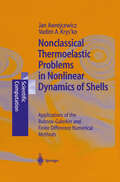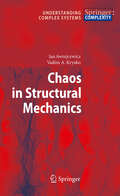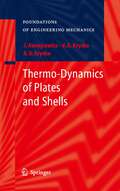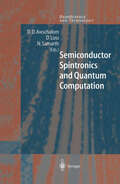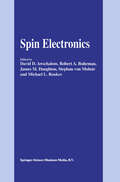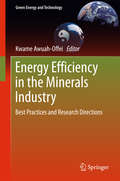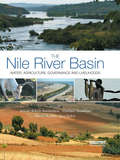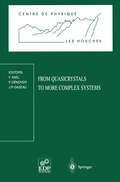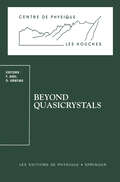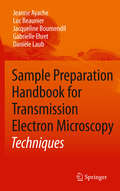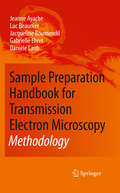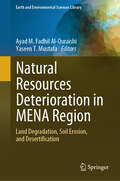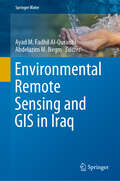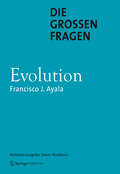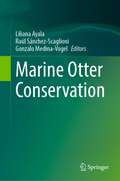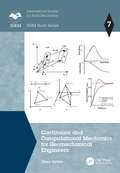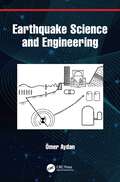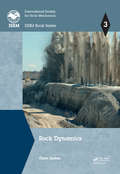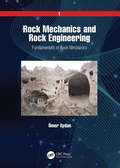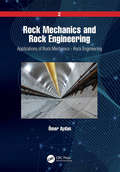- Table View
- List View
Nonclassical Thermoelastic Problems in Nonlinear Dynamics of Shells: Applications of the Bubnov-Galerkin and Finite Difference Numerical Methods (Scientific Computation)
by Jan Awrejcewicz Vadim A. KryskoFrom the reviews: "A unique feature of this book is the nice blend of engineering vividness and mathematical rigour. [...] The authors are to be congratulated for their valuable contribution to the literature in the area of theoretical thermoelasticity and vibration of plates." Journal of Sound and Vibration
Chaos in Structural Mechanics (Understanding Complex Systems)
by Jan Awrejcewicz Vadim Anatolevich Krys'koThermo-Dynamics of Plates and Shells (Foundations of Engineering Mechanics)
by Jan Awrejcewicz Vadim Anatolevich Krys'ko Anton V. Krys'koThis monograph is devoted to nonlinear dynamics of thin plates and shells with thermosensitive excitation. Because of the variety of sizes and types of mathematical models in current use, there is no prospect of solving them analytically. However, the book emphasizes a rigorous mathematical treatment of the obtained differential equations, since it helps efficiently in further developing of various suitable numerical algorithms to solve the stated problems.
Semiconductor Spintronics and Quantum Computation (NanoScience and Technology)
by D. D. Awschalom D. Loss N. SamarthThe past few decades of research and development in solid-state semicon ductor physics and electronics have witnessed a rapid growth in the drive to exploit quantum mechanics in the design and function of semiconductor devices. This has been fueled for instance by the remarkable advances in our ability to fabricate nanostructures such as quantum wells, quantum wires and quantum dots. Despite this contemporary focus on semiconductor "quantum devices," a principal quantum mechanical aspect of the electron - its spin has it accounts for an added quan largely been ignored (except in as much as tum mechanical degeneracy). In recent years, however, a new paradigm of electronics based on the spin degree of freedom of the electron has begun to emerge. This field of semiconductor "spintronics" (spin transport electron ics or spin-based electronics) places electron spin rather than charge at the very center of interest. The underlying basis for this new electronics is the intimate connection between the charge and spin degrees of freedom of the electron via the Pauli principle. A crucial implication of this relationship is that spin effects can often be accessed through the orbital properties of the electron in the solid state. Examples for this are optical measurements of the spin state based on the Faraday effect and spin-dependent transport measure ments such as giant magneto-resistance (GMR). In this manner, information can be encoded in not only the electron's charge but also in its spin state, i. e.
Spin Electronics
by David D. Awschalom Robert A. Buhrman James M. Daughton Stephan Von Molnár Michael L. RoukesThe history of scientific research and technological development is replete with examples of breakthroughs that have advanced the frontiers of knowledge, but seldom does it record events that constitute paradigm shifts in broad areas of intellectual pursuit. One notable exception, however, is that of spin electronics (also called spintronics, magnetoelectronics or magnetronics), wherein information is carried by electron spin in addition to, or in place of, electron charge. It is now well established in scientific and engineering communities that Moore's Law, having been an excellent predictor of integrated circuit density and computer performance since the 1970s, now faces great challenges as the scale of electronic devices has been reduced to the level where quantum effects become significant factors in device operation. Electron spin is one such effect that offers the opportunity to continue the gains predicted by Moore's Law, by taking advantage of the confluence of magnetics and semiconductor electronics in the newly emerging discipline of spin electronics. From a fundamental viewpoine, spin-polarization transport in a material occurs when there is an imbalance of spin populations at the Fermi energy. In ferromagnetic metals this imbalance results from a shift in the energy states available to spin-up and spin-down electrons. In practical applications, a ferromagnetic metal may be used as a source of spin-polarized electronics to be injected into a semiconductor, a superconductor or a normal metal, or to tunnel through an insulating barrier.
Energy Efficiency in the Minerals Industry: Best Practices and Research Directions (Green Energy and Technology)
by Kwame Awuah-OffeiThis book presents a state-of-the-art analysis of energy efficiency as applied to mining processes. From ground fragmentation to mineral processing and extractive metallurgy, experts discuss the current state of knowledge and the nagging questions that call for further research. It offers an excellent resource for all mine managers and engineers who want to improve energy efficiency to boost both production efficiency and sustainability. It will also benefit graduate students and experienced researchers looking for a comprehensive review of the current state of knowledge concerning energy efficiency in the minerals industry.
The Nile River Basin: Water, Agriculture, Governance and Livelihoods (Earthscan Series on Major River Basins of the World)
by Seleshi Bekele Awulachew Vladimir Smakhtin David Molden Don PedenThe Nile provides freshwater not only for domestic and industrial use, but also for irrigated agriculture, hydropower dams and the vast fisheries resource of the lakes of Central Africa. The Nile River Basin covers the whole Nile Basin and is based on the results of three major research projects supported by the Challenge Program on Water and Food (CPWF). It provides unique and up-to-date insights on agriculture, water resources, governance, poverty, productivity, upstream-downstream linkages, innovations, future plans and their implications. Specifically, the book elaborates the history and the major current and future challenges and opportunities of the Nile river basin. It analyzes the basin characteristics using statistical data and modern tools such as remote sensing and geographic information systems. Population distribution, poverty and vulnerability linked to production system and water access are assessed at the international basin scale, and the hydrology of the region is also analysed. This text provides in-depth scientific model adaptation results for hydrology, sediments, benefit sharing, and payment for environmental services based on detailed scientific and experimental work of the Blue Nile Basin. Production systems as they relate to crops, livestock, fisheries and wetlands are analyzed for the whole Blue and White Nile basin including their constraints. Policy, institutional and technological interventions that increase productivity of agriculture and use of water are also assessed. Water demand modeling, scenario analysis, and tradeoffs that inform future plans and opportunities are included to provide a unique, comprehensive coverage of the subject.
The Nile River Basin: Water, Agriculture, Governance and Livelihoods (Earthscan Series on Major River Basins of the World)
by Seleshi Bekele Awulachew Vladimir Smakhtin David Molden Don PedenThe Nile provides freshwater not only for domestic and industrial use, but also for irrigated agriculture, hydropower dams and the vast fisheries resource of the lakes of Central Africa. The Nile River Basin covers the whole Nile Basin and is based on the results of three major research projects supported by the Challenge Program on Water and Food (CPWF). It provides unique and up-to-date insights on agriculture, water resources, governance, poverty, productivity, upstream-downstream linkages, innovations, future plans and their implications. Specifically, the book elaborates the history and the major current and future challenges and opportunities of the Nile river basin. It analyzes the basin characteristics using statistical data and modern tools such as remote sensing and geographic information systems. Population distribution, poverty and vulnerability linked to production system and water access are assessed at the international basin scale, and the hydrology of the region is also analysed. This text provides in-depth scientific model adaptation results for hydrology, sediments, benefit sharing, and payment for environmental services based on detailed scientific and experimental work of the Blue Nile Basin. Production systems as they relate to crops, livestock, fisheries and wetlands are analyzed for the whole Blue and White Nile basin including their constraints. Policy, institutional and technological interventions that increase productivity of agriculture and use of water are also assessed. Water demand modeling, scenario analysis, and tradeoffs that inform future plans and opportunities are included to provide a unique, comprehensive coverage of the subject.
From Quasicrystals to More Complex Systems: Les Houches School, February 23 – March 6, 1998 (Centre de Physique des Houches #13)
by F. Axel F. Denoyer J. P. GazeauThis book is a collection of part of the written versions of the Physics Courses given at the Winter School "Order, Chance and Risk: Aperiodic Phenomena from Solid State to Finance" held at the Les Houches Center for Physics, between February 23 and March 6, 1998. The School gathered lecturers and participants from all over the world. On a thematic level, the content of the school can be viewed both as a continuation (aperiodic phenomena in solid state physics) and an extension (mathematical aspects of fmance and economy) of the previous "Beyond Quasicrystals", also held at Les Houches, March 7-18 1994 and published in the same ·series. One of its important goals was to promote in-depth concrete scientific exchanges between theoretical physicists, experimental physicists and mathematicians on the one hand, and on the other hand practitioners of the economico-fmancial sphere and specialists of financial mathematics. Therefore, besides the mathematical tools and concepts at work in theoretical descriptions, relevant experimental data were also presented together with methods allowing their interpretation. As a result of this choice, the School was stimulated by experimentalists and fmancial market operators who joined the theoretical physicists and mathematicians at the conference. The present volume deals with the theoretical and experimental studies on aperiodic solids with long range order, incommensurate phases, quasicrystals, glasses, and more complex systems (fractal, chaotic), while a second volume to appear in the same series is devoted to the finance and economy facet.
Beyond Quasicrystals: Les Houches, March 7–18, 1994 (Centre de Physique des Houches #3)
by Françoise Axel Denis GratiasThis book is the collection of most of the written versions of the Courses given at the Winter School "Beyond Quasicrystals" in Les Houches (March 7-18, 1994). The School gathered lecturers and participants from all over the world and was prepared in the spirit of a general effort to promote theoretical and experimental interdisciplinary communication between mathematicians, theoretical and experimental physicists on the topic of the nature of geometric order in solids beyond standard periodicity and quasi periodicity. The overall structure of the book reflects the wish of the editors to pose this fundamental question of geometric order in solids from both the experimental and theoretical point of view. The first part is devoted more specifically to quasicrystals. These materials were the common starting point of most of the audience and present a first concrete example of a non-trivial geometric order. We chose to focus on a few fundamental aspects of quasicrystals related to hidden symmetries in solids which are not easily found in standard textbooks on the topic, not to reach an exhaustive survey which is already available elsewhere.
Sample Preparation Handbook for Transmission Electron Microscopy: Techniques
by Jeanne Ayache Luc Beaunier Jacqueline Boumendil Gabrielle Ehret Danièle LaubSuccessful transmission electron microscopy in all of its manifestations depends on the quality of the specimens examined. Biological specimen preparation protocols have usually been more rigorous and time consuming than those in the physical sciences. For this reason, there has been a wealth of scienti c literature detailing speci c preparation steps and numerous excellent books on the preparation of b- logical thin specimens. This does not mean to imply that physical science specimen preparation is trivial. For the most part, most physical science thin specimen pre- ration protocols can be executed in a matter of a few hours using straightforward steps. Over the years, there has been a steady stream of papers written on various aspects of preparing thin specimens from bulk materials. However, aside from s- eral seminal textbooks and a series of book compilations produced by the Material Research Society in the 1990s, no recent comprehensive books on thin specimen preparation have appeared until this present work, rst in French and now in English. Everyone knows that the data needed to solve a problem quickly are more imp- tant than ever. A modern TEM laboratory with supporting SEMs, light microscopes, analytical spectrometers, computers, and specimen preparation equipment is an investment of several million US dollars. Fifty years ago, electropolishing, chemical polishing, and replication methods were the principal specimen preparation me- ods.
Sample Preparation Handbook for Transmission Electron Microscopy: Methodology
by Jeanne Ayache Danièle Laub Jacqueline Boumendil Gabrielle Ehret Luc BeaunierSuccessful transmission electron microscopy in all of its manifestations depends on the quality of the specimens examined. Biological specimen preparation protocols have usually been more rigorous and time consuming than those in the physical sciences. For this reason, there has been a wealth of scienti?c literature detailing speci?c preparation steps and numerous excellent books on the preparation of b- logical thin specimens. This does not mean to imply that physical science specimen preparation is trivial. For the most part, most physical science thin specimen pre- ration protocols can be executed in a matter of a few hours using straightforward steps. Over the years, there has been a steady stream of papers written on various aspects of preparing thin specimens from bulk materials. However, aside from s- eral seminal textbooks and a series of book compilations produced by the Material Research Society in the 1990s, no recent comprehensive books on thin spe- men preparation have appeared until this present work, ?rst in French and now in English. Everyone knows that the data needed to solve a problem quickly are more imp- tant than ever. A modern TEM laboratory with supporting SEMs, light microscopes, analytical spectrometers, computers, and specimen preparation equipment is an investment of several million US dollars. Fifty years ago, electropolishing, chemical polishing, and replication methods were the principal specimen preparation me- ods.
Natural Resources Deterioration in MENA Region: Land Degradation, Soil Erosion, and Desertification (Earth and Environmental Sciences Library)
by Ayad M. Fadhil Al-Quraishi Yaseen T. MustafaLand deterioration, drought, desertification, and water resources shrinkage threaten natural resources, negatively impacting environmental, economic, and political stability. The increasing occurrence of climate change (extremes) impacts land degradation processes, soil erosion by water and wind, and salinization. The researchers have invested several years of scientific research in natural resources deterioration, including soil degradation and erosion, land degradation, desertification, and climate changes, which are interesting enough. However, the link between science and policymaking appears to be less active as serious actions do not take fast. The eighteen chapters of this book focus more on topics related to natural resources deterioration, such as land degradation, desertification, drought, climate change, and analysis of numerous case studies. This book presents experts' overviews, study results, experiences, and knowledge of natural resources deterioration in MENA countries. It attracts researchers, experts, scholars, scientists, academics, students, practitioners, graduates, or anybody interested in land degradation, desertification, climate change, and natural hazards that fall within natural resources deterioration. Therefore, researchers keep continuing to do their investigations and produce results that convince stakeholders and policymaking to act immediately towards protecting natural resources and their sustainability.
Environmental Remote Sensing and GIS in Iraq (Springer Water)
by Ayad M. Fadhil Al-Quraishi Abdelazim M. NegmThis unique book focuses on remote sensing (RS) and geographical information systems (GIS) in Iraq. The environmental applications include monitoring and mapping soil salinity and prediction of soil properties, monitoring and mapping of land threats, proximal sensing for soil monitoring and soil fertility, spatiotemporal land use/cover, agricultural drought monitoring, hydrological applications including spatial rainfall distribution, surface runoff and drought control, geo-morphometric analysis and flood simulation, hydrologic and hydraulic modelling and the effective management of water resources. Also, this book assesses the impacts of climate change on natural resources using both RS and GIS, as well as other applications, covering different parts of Iraq. The book chapters include tens of maps extracted from the remotely sensed datasets, in addition to tables and statistical relations obtained from the results of the studies of the chapters' authors. These studies have been conducted in different parts of Iraq; in the north (Kurdistan region) with its mountainous and undulating lands, in western parts which have desert soils, and in central and southern Iraq where there are salty soils, dunes, wetlands, and marshes.The book is written by distinguished scientists from Iraq, China, USA, Italy, Iran, Germany, and the Czech Republic who are interested in the Iraqi environment. The book is therefore a useful source of information and knowledge on Iraqi environment for graduate students, researchers, policy planners, and stakeholders in Iraq as well as similar regions.
Die großen Fragen - Evolution
by Francisco J AyalaDie großen Fragen behandeln grundlegende Probleme und Konzepte in Wissenschaft und Philosophie, die Forscher und Denker seit jeher umtreiben. Anspruch der ambitionierten Reihe ist es, die Antworten auf diese Fragen zu präsentieren und damit die wichtigsten Gedanken der Menschheit in einzigartigen Übersichten zu bündeln. Im vorliegenden Band Evolution widmet sich Francisco Ayala 20 bedeutenden Fragen zu Ursprung und Entwicklung des Lebens auf der Erde, zur Vielfalt der Organismen und zur Stellung des Menschen.
Marine Otter Conservation
by Liliana Ayala Raúl Sánchez-Scaglioni Gonzalo Medina-VogelThis book offers a multidisciplinary approach to conservation issues related to the marine otter (Lontra felina). The main goal is the systematization of different research efforts on this species, to contribute with conservation policy design and implementation. The authors contribute their achievements in conservation, ecology, status in freshwater habitats, habitat fragmentation effects, interaction with human activities and recommendations for an effective conservation of the species. The book is directed first and foremost towards researchers and authorities and people involved in conservation tasks of otters.Despite in the last decades some studies and efforts on Lontra felina has carried in Peru and Chile, some information can be gathered to fill the gaps on marine otter conservation in Peru. That is the main goal of the book Conservation of Marine Otter. Moreover, the publication will be the first book published at international level on Lontra felina with the participation of several experimented researchers on this threatened and endemic species.
Continuum and Computational Mechanics for Geomechanical Engineers (ISRM Book Series #1)
by Ömer AydanThe field of rock mechanics and rock engineering utilizes the basic laws of continuum mechanics and the techniques developed in computational mechanics. This book describes the basic concepts behind these fundamental laws and their utilization in practice irrespective of whether rock/rock mass contains discontinuities. This book consists of nine chapters and six appendices. The first four chapters are concerned with continuum mechanics aspects, which include the basic operations, definition of stress and strain tensors, and derivation of four fundamental conservation laws in the simplest yet precise manner. The next two chapters are the preparation for computational mechanics, which require constitutive laws of geomaterials relevant to each conservation law and the procedures for how to determine required parameters of the constitutive laws. Computational mechanics solves the resulting ordinary and partial differential equations. In Chapter 7, the methods of exact (closed-form) solutions are explained and they are applied to ordinary/partial differential equations with solvable boundary and initial conditions. In Chapter 8, the fundamentals of approximate solution methods are explained for one dimension first and then how to extend them to multi-dimensional problems. The readers are expected to learn and clearly understand how they are derived and applied to various problems in geomechanics. The final chapter involves the applications of the approximate methods to the actual problems in practice for geomechanical engineers, which cover the continuum to discontinuum, including the stress state of the earth as well as the ground motions induced by earthquakes. Six appendices are provided to have a clear understanding of continuum mechanics operations and procedures for how to deal with discontinuities/interfaces often encountered in rock mechanics and rock engineering.
Continuum and Computational Mechanics for Geomechanical Engineers (ISRM Book Series #1)
by Ömer AydanThe field of rock mechanics and rock engineering utilizes the basic laws of continuum mechanics and the techniques developed in computational mechanics. This book describes the basic concepts behind these fundamental laws and their utilization in practice irrespective of whether rock/rock mass contains discontinuities. This book consists of nine chapters and six appendices. The first four chapters are concerned with continuum mechanics aspects, which include the basic operations, definition of stress and strain tensors, and derivation of four fundamental conservation laws in the simplest yet precise manner. The next two chapters are the preparation for computational mechanics, which require constitutive laws of geomaterials relevant to each conservation law and the procedures for how to determine required parameters of the constitutive laws. Computational mechanics solves the resulting ordinary and partial differential equations. In Chapter 7, the methods of exact (closed-form) solutions are explained and they are applied to ordinary/partial differential equations with solvable boundary and initial conditions. In Chapter 8, the fundamentals of approximate solution methods are explained for one dimension first and then how to extend them to multi-dimensional problems. The readers are expected to learn and clearly understand how they are derived and applied to various problems in geomechanics. The final chapter involves the applications of the approximate methods to the actual problems in practice for geomechanical engineers, which cover the continuum to discontinuum, including the stress state of the earth as well as the ground motions induced by earthquakes. Six appendices are provided to have a clear understanding of continuum mechanics operations and procedures for how to deal with discontinuities/interfaces often encountered in rock mechanics and rock engineering.
Earthquake Science and Engineering
by Ömer AydanEarthquakes form one of the categories of natural disasters that sometimes result in huge loss of human life as well as destruction of (infra)structures, as experienced during recent great earthquakes. This book addresses scientific and engineering aspects of earthquakes, which are generally taught and published separately. This book intends to fill the gap between these two fields associated with earthquakes and help seismologists and earthquake engineers better communicate with and understand each other. This will foster the development of new techniques for dealing with various aspects of earthquakes and earthquake-associated issues, to safeguard the security and welfare of societies worldwide. Because this work covers both scientific and engineering aspects in a unified way, it offers a complete overview of earthquakes, their mechanics, their effects on (infra)structures and secondary associated events. As such, this book is aimed at engineering professionals with an earth sciences background (geology, seismology, geophysics) or those with an engineering background (civil, architecture, mining, geological engineering) or with both, and it can also serve as a reference work for academics and (under)graduate students.
Earthquake Science and Engineering
by Ömer AydanEarthquakes form one of the categories of natural disasters that sometimes result in huge loss of human life as well as destruction of (infra)structures, as experienced during recent great earthquakes. This book addresses scientific and engineering aspects of earthquakes, which are generally taught and published separately. This book intends to fill the gap between these two fields associated with earthquakes and help seismologists and earthquake engineers better communicate with and understand each other. This will foster the development of new techniques for dealing with various aspects of earthquakes and earthquake-associated issues, to safeguard the security and welfare of societies worldwide. Because this work covers both scientific and engineering aspects in a unified way, it offers a complete overview of earthquakes, their mechanics, their effects on (infra)structures and secondary associated events. As such, this book is aimed at engineering professionals with an earth sciences background (geology, seismology, geophysics) or those with an engineering background (civil, architecture, mining, geological engineering) or with both, and it can also serve as a reference work for academics and (under)graduate students.
Rock Dynamics (ISRM Book Series)
by Omer AydanRock dynamics has become one of the most important topics in the field of rock mechanics and rock engineering. The spectrum of rock dynamics is very wide and it includes the failure of rocks, rock masses and rock engineering structures such as rockbursting, spalling, popping, collapse, toppling, sliding, blasting, non-destructive testing, geophysical explorations, science and engineering of rocks and impacts. The book specifically covers fundamentals of rock dynamics, constitutive models, numerical analysis techniques, dynamic testing procedures, the multi-parameter responses and motions of rocks during fracturing or slippage in laboratory experiments, earthquakes and their strong motion characteristics and their effect on various rock structures such as foundations, underground structures, slopes, dynamic simulation of loading and excavation, blasting and its positive utilization in rock engineering, the phenomenon of rockburst in rock excavations, non-destructive testing of rockbolts and rock anchors and impacts by meteors or projectiles. The main goal of this book is to present a unified and complete treatise on Rock Dynamics and to represent a milestone in advancing the knowledge in this field and in leading to new techniques for experiments, analytical and numerical modelling as well as monitoring of dynamics of rocks and rock engineering structures.
Rock Dynamics (ISRM Book Series)
by Omer AydanRock dynamics has become one of the most important topics in the field of rock mechanics and rock engineering. The spectrum of rock dynamics is very wide and it includes the failure of rocks, rock masses and rock engineering structures such as rockbursting, spalling, popping, collapse, toppling, sliding, blasting, non-destructive testing, geophysical explorations, science and engineering of rocks and impacts. The book specifically covers fundamentals of rock dynamics, constitutive models, numerical analysis techniques, dynamic testing procedures, the multi-parameter responses and motions of rocks during fracturing or slippage in laboratory experiments, earthquakes and their strong motion characteristics and their effect on various rock structures such as foundations, underground structures, slopes, dynamic simulation of loading and excavation, blasting and its positive utilization in rock engineering, the phenomenon of rockburst in rock excavations, non-destructive testing of rockbolts and rock anchors and impacts by meteors or projectiles. The main goal of this book is to present a unified and complete treatise on Rock Dynamics and to represent a milestone in advancing the knowledge in this field and in leading to new techniques for experiments, analytical and numerical modelling as well as monitoring of dynamics of rocks and rock engineering structures.
Rock Mechanics and Rock Engineering: Volume 1: Fundamentals of Rock Mechanics
by Ömer AydanThe two-volume set Rock Mechanics and Rock Engineering is concerned with the application of the principles of mechanics to physical, chemical and electro-magnetic processes in the upper-most layers of the earth and the design and construction of the rock structures associated with civil engineering and exploitation or extraction of natural resources in mining and petroleum engineering. Volume 1, Fundamentals of Rock Mechanics, discusses rock-constituting elements, discontinuities and their behavior under various physical and chemical actions in nature. The governing equations together with constitutive laws and experimental techniques and the solution techniques are explained and some examples of applications are given. A number of chapters are devoted to possible new directions in rock mechanics. Rock Mechanics and Rock Engineering is intended to be a fundamental resource for younger generations and newcomers and a reference book for experts specialized in Rock Mechanics and Rock Engineering and associated with the fields of mining, civil and petroleum engineering, engineering geology, and/or specialized in Geophysics and concerned with earthquake science and engineering.
Rock Mechanics and Rock Engineering: Volume 1: Fundamentals of Rock Mechanics
by Ömer AydanThe two-volume set Rock Mechanics and Rock Engineering is concerned with the application of the principles of mechanics to physical, chemical and electro-magnetic processes in the upper-most layers of the earth and the design and construction of the rock structures associated with civil engineering and exploitation or extraction of natural resources in mining and petroleum engineering. Volume 1, Fundamentals of Rock Mechanics, discusses rock-constituting elements, discontinuities and their behavior under various physical and chemical actions in nature. The governing equations together with constitutive laws and experimental techniques and the solution techniques are explained and some examples of applications are given. A number of chapters are devoted to possible new directions in rock mechanics. Rock Mechanics and Rock Engineering is intended to be a fundamental resource for younger generations and newcomers and a reference book for experts specialized in Rock Mechanics and Rock Engineering and associated with the fields of mining, civil and petroleum engineering, engineering geology, and/or specialized in Geophysics and concerned with earthquake science and engineering.
Rock Mechanics and Rock Engineering: Volume 2: Applications of Rock Mechanics - Rock Engineering
by Ömer AydanThe two-volume set Rock Mechanics and Rock Engineering is concerned with the application of the principles of mechanics to physical, chemical and electro-magnetic processes in the upper-most layers of the earth and the design and construction of the rock structures associated with civil engineering and exploitation or extraction of natural resources in mining and petroleum engineering. Volume 2, Applications of Rock Mechanics – Rock Engineering, discusses the applications of rock mechanics to engineering structures in/on rock, rock excavation techniques and in-situ monitoring techniques, giving some specific examples. The dynamic aspects associated with the science of earthquakes and their effect on rock structures, and the characteristics of vibrations induced by machinery, blasting and impacts as well as measuring techniques are described. Furthermore, the degradation and maintenance processes in rock engineering are explained. Rock Mechanics and Rock Engineering is intended to be a fundamental resource for younger generations and newcomers and a reference book for experts specialized in Rock Mechanics and Rock Engineering and associated with the fields of mining, civil and petroleum engineering, engineering geology, and/or specialized in Geophysics and concerned with earthquake science and engineering.
